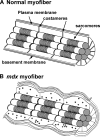Mechanisms of muscle weakness in muscular dystrophy
- PMID: 20584890
- PMCID: PMC2894554
- DOI: 10.1085/jgp.201010436
Mechanisms of muscle weakness in muscular dystrophy
Figures

Similar articles
-
Expression of transforming growth factor-beta 1 and its relation to endomysial fibrosis in progressive muscular dystrophy.Am J Pathol. 1994 Feb;144(2):221-6. Am J Pathol. 1994. PMID: 8311110 Free PMC article.
-
Absence of Dystrophin Disrupts Skeletal Muscle Signaling: Roles of Ca2+, Reactive Oxygen Species, and Nitric Oxide in the Development of Muscular Dystrophy.Physiol Rev. 2016 Jan;96(1):253-305. doi: 10.1152/physrev.00007.2015. Physiol Rev. 2016. PMID: 26676145 Free PMC article. Review.
-
Defective membrane repair in dysferlin-deficient muscular dystrophy.Nature. 2003 May 8;423(6936):168-72. doi: 10.1038/nature01573. Nature. 2003. PMID: 12736685
-
Targeted inhibition of TGF-β results in an initial improvement but long-term deficit in force production after contraction-induced skeletal muscle injury.J Appl Physiol (1985). 2013 Aug 15;115(4):539-45. doi: 10.1152/japplphysiol.00374.2013. Epub 2013 Jun 13. J Appl Physiol (1985). 2013. PMID: 23766498 Free PMC article.
-
Dystrophin-glycoprotein complex: its role in the molecular pathogenesis of muscular dystrophies.Muscle Nerve. 1994 Jan;17(1):2-15. doi: 10.1002/mus.880170103. Muscle Nerve. 1994. PMID: 8264699 Review.
Cited by
-
Apoptosis repressor with a CARD domain (ARC) restrains Bax-mediated pathogenesis in dystrophic skeletal muscle.PLoS One. 2013 Dec 2;8(12):e82053. doi: 10.1371/journal.pone.0082053. eCollection 2013. PLoS One. 2013. PMID: 24312627 Free PMC article.
-
Eteplirsen Treatment Attenuates Respiratory Decline in Ambulatory and Non-Ambulatory Patients with Duchenne Muscular Dystrophy.J Neuromuscul Dis. 2019;6(2):213-225. doi: 10.3233/JND-180351. J Neuromuscul Dis. 2019. PMID: 30856119 Free PMC article.
-
The passive mechanical properties of the extensor digitorum longus muscle are compromised in 2- to 20-mo-old mdx mice.J Appl Physiol (1985). 2011 Jun;110(6):1656-63. doi: 10.1152/japplphysiol.01425.2010. Epub 2011 Mar 17. J Appl Physiol (1985). 2011. PMID: 21415170 Free PMC article.
-
Label-free histological imaging of tissues using Brillouin light scattering contrast.Biomed Opt Express. 2021 Feb 17;12(3):1437-1448. doi: 10.1364/BOE.414474. eCollection 2021 Mar 1. Biomed Opt Express. 2021. PMID: 33796364 Free PMC article.
-
Nitric oxide-dependent attenuation of noradrenaline-induced vasoconstriction is impaired in the canine model of Duchenne muscular dystrophy.J Physiol. 2018 Nov;596(21):5199-5216. doi: 10.1113/JP275672. Epub 2018 Sep 20. J Physiol. 2018. PMID: 30152022 Free PMC article.
References
-
- Bernasconi P., Torchiana E., Confalonieri P., Brugnoni R., Barresi R., Mora M., Cornelio F., Morandi L., Mantegazza R. 1995. Expression of transforming growth factor-beta 1 in dystrophic patient muscles correlates with fibrosis. Pathogenetic role of a fibrogenic cytokine. J. Clin. Invest. 96:1137–1144 10.1172/JCI118101 - DOI - PMC - PubMed
-
- Cohn R.D., van Erp C., Habashi J.P., Soleimani A.A., Klein E.C., Lisi M.T., Gamradt M., ap Rhys C.M., Holm T.M., Loeys B.L., et al. 2007. Angiotensin II type 1 receptor blockade attenuates TGF-beta-induced failure of muscle regeneration in multiple myopathic states. Nat. Med. 13:204–210 10.1038/nm1536 - DOI - PMC - PubMed
Publication types
MeSH terms
Substances
Grants and funding
LinkOut - more resources
Full Text Sources
Other Literature Sources
Medical

